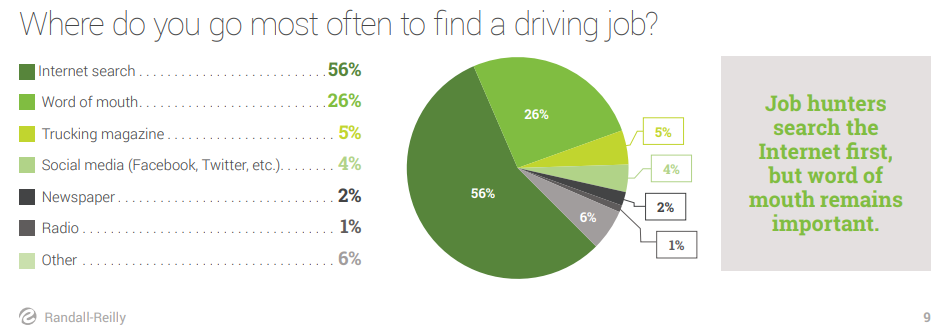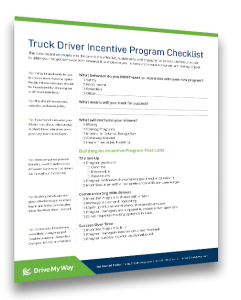
To hire the best truck drivers, recruiters need to constantly create a good impression of their carriers. However, there’s only so much you can do as a recruiter to control your brand and reputation. Unfortunately, many advertisements lie, and drivers have good reason not to believe everything that a carrier says about itself. That’s why they’re more likely to listen to other drivers instead. People are more likely to listen to those they trust, and they’re more likely to trust those who are similar to them. The power of peers is so great that people are 4 times more likely to buy a product when referred by a friend. You can harness this power in the trucking industry as well. A potential driver for your fleet is more likely to trust a fellow driver than what you have to say about your fleet.
This is the idea behind creating a driver referral program. Since your reputation as a carrier is going to spread anyway, you may as well use that to your advantage to attract the best candidates.
Research shows that “word of mouth” plays a huge factor for drivers looking for trucking jobs.
According to the 2019 Overdrive Connectivity Report, 26% of company drivers use word of mouth when looking for driving jobs, second only to Internet searches. Meanwhile, it’s the strongest factor for owner-operators, who look to it 39% of the time. A driver referral program will help you harness the power of word-of-mouth and use your company reputation to bring the strongest drivers to your fleet. Here are 3 tips to create a strong referral program.
1. Build advocates
 As we mentioned, drivers are already speaking to each other about your carrier. Your company already has a reputation, and you can’t override it by a referral program. Either your drivers believe you have a strong company and culture that values them, or they don’t. You can’t magically change their opinion by using incentives, but you can encourage them to share their opinions with other drivers.
As we mentioned, drivers are already speaking to each other about your carrier. Your company already has a reputation, and you can’t override it by a referral program. Either your drivers believe you have a strong company and culture that values them, or they don’t. You can’t magically change their opinion by using incentives, but you can encourage them to share their opinions with other drivers.
Offering incentives nudges your drivers to make referrals they already believe in.
It just adds the extra benefit that it won’t slip their mind between a busy job and personal life. If drivers already believe in the strength of your company, you’re really building them as advocates for your company, and not simply as referrals.
2. Structure incentives
 Many companies use incentives to nudge drivers into making referrals. Most of these incentives are monetary rewards, although they don’t have to be. As we learned in high school economics class, incentives matter.
Many companies use incentives to nudge drivers into making referrals. Most of these incentives are monetary rewards, although they don’t have to be. As we learned in high school economics class, incentives matter.
You have to make sure you’re offering the right incentives, and that they are influencing behavior in ways you want them to.
If you’re offering a vinyl record player as an incentive and all your drivers use MP3 files for their music, you aren’t going to get any referrals even if everyone loves your company! Make the referral worth it for your drivers. If you’re offering a monetary reward, there are different ways to distribute it. For example, a $500 referral bonus can be spaced out- $250 when the referred driver gets their first run completed and another $250 when they’ve been with the company for 60 days. Often the incentive doesn’t begin until the new driver has already joined the fleet. Driver benefits like extra paid vacation time are other referral rewards which many drivers will covet. Find the right incentive structure and distribution mechanism that works for your company!
3. Build Your Budget
 It’s easy to think of referral programs as a waste of money if you haven’t used them before or measured their impact. Try to think of driver referrals as an investment into your recruiting budget. The hire you make from a referral program will help you gain back the amount you spent on the incentive or reward. In fact, you can measure the impact of your referral program and calculate the return on investment. If you’re doing it well then you make a significant number of hires which more than account for the budget spent on the referral program. Consider these budgetary issues when structuring your referral program.
It’s easy to think of referral programs as a waste of money if you haven’t used them before or measured their impact. Try to think of driver referrals as an investment into your recruiting budget. The hire you make from a referral program will help you gain back the amount you spent on the incentive or reward. In fact, you can measure the impact of your referral program and calculate the return on investment. If you’re doing it well then you make a significant number of hires which more than account for the budget spent on the referral program. Consider these budgetary issues when structuring your referral program.
If your program is losing more money than gaining, you need to seriously re-think your entire driver referral program.
Which incentives aren’t working? Should the monetary reward be greater? Maybe the rewards need to be spread out more or be delivered only after you’ve converted leads to hires. Don’t forget to account for the hundreds of dollars being wasted on trucks sitting idle in your lot. Investing in a driver referral program might a way to end that loss of value.

 Comprehensive CDL Recruitment Solutions
Comprehensive CDL Recruitment Solutions



 No matter how great your referral program is, drivers won’t participate if they don’t believe what they’re selling. Talk to your current drivers about what they enjoy most about your company, and what would make it better. More PTO, home time, and performance-based bonuses are common answers. Showing that the company is making an active effort to improve the
No matter how great your referral program is, drivers won’t participate if they don’t believe what they’re selling. Talk to your current drivers about what they enjoy most about your company, and what would make it better. More PTO, home time, and performance-based bonuses are common answers. Showing that the company is making an active effort to improve the 





